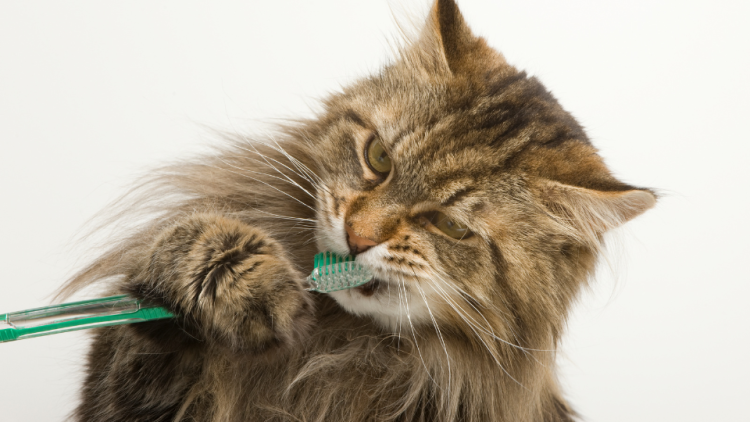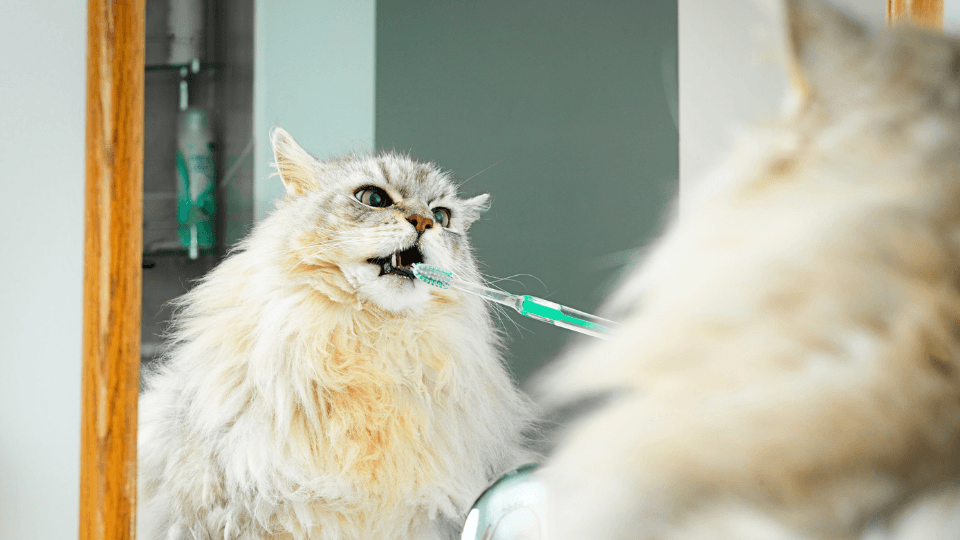Like humans, cats too require daily dental care in order to prevent tartar and plaque accumulation. In actuality, 90% of felines over the age of four years old will experience dental disease. In addition to causing pain, tooth loss, and infection, dental disease can shorten your cat's lifespan if bacteria from a mouth infection enter the animal’s bloodstream.
Daily brushing is the best thing you can do to maintain your cat’s dental health. Although cleaning a cat's teeth may seem like an insurmountable undertaking, most cats can be trained to tolerate and even enjoy the process with the right tips and tricks (along with some persistence and patience).
Below, you'll learn step-by-step instructions on how to brush your cats teeth with advice on how to make the process painless for both you and your pet. Here is what we’ll cover:
- Why should I brush my cat's teeth?
- Step-by-step guide to brushing your cat's teeth
- When should I brush my cat's teeth?
- How often should I brush my cat's teeth?
- What type of toothbrush should I use for my cat?
- Is there anything else I should know about my cat's dental care?
Why should I brush my cat's teeth?
More than 50% of felines older than three years have periodontal disease (infection of the surrounding tissue of the teeth). If plaque is not regularly eliminated by brushing, it thickens and turns into tartar. When plaque comes into touch with the gums, it causes gingivitis, which is the precursor to periodontal disease, a painful condition that can ultimately result in tooth loss, if left untreated.
Step-by-step guide to brushing your cat's teeth
It will take some practice to get your pet used to brushing, but once they do, they will benefit plenty from the experience. Daily brushing is ideal because it will help your pet develop a pattern, but twice or three times a week is also okay if your schedule doesn't allow for daily brushing.
Making brushing your cat's teeth enjoyable for both of you will increase your chances of success. Follow these guidelines on how to clean cats teeth to get the best results:
Step 1: Get the right tools to clean cats' teeth
There are toothbrushes for cats on the market exclusively made for the feline anatomy. These consist of finger toothbrushes, small-bristle brushes, and brushes with angled handles. It's best to use a brush with bristles that can reach just below the gum line at the tooth/gum interface, but if you are still not sure what to choose, talk to your veterinarian.
Step 2: Get your cat comfortable with oral handling
It is preferable to start training your feline friend to get used to brushing while they’re a young kitten. The procedure could take longer if your cat is older.
Here are a few tips to help get your four-legged friend comfortable with oral handling:
- Pick a peaceful time and location to start. Choose a small space where you can sit with your cat on your lap, or set them on a surface like a tabletop or counter.
- Dab a Q-tip cotton swab in tuna water that has been drained from a tuna fish can. The majority of cats enjoy the flavor of tuna water despite the fact that it has no cleaning properties. This will help create a good association between the tuna water and the experience of brushing teeth.
- Tilt your pet’s head back at a 45-degree angle and pull their lips back gently. Run the swab along the tooth surface where the gum tissue meets it. This is where plaque gathers and the first signs of gingivitis appear. Massage only the outer surfaces of the tooth.
Step 3: Add the toothpaste
Once your feline friend is comfortable with this, you might try letting them taste some toothpaste from your finger. Never use human toothpaste as it contains ingredients (such as sodium and fluoride) that can be harmful to cats.
If ingested, it might result in digestive problems or stomach upset. There are many different flavors of cat-friendly pet toothpaste available. Your cat is more likely to appreciate the entire process if you use a product that tastes good.
Step 4: Introduce the toothbrush
Once the cat has accepted the taste of the toothpaste, it’s time to introduce the toothbrush. Put it under your cat's lips, touch it to their face, and then gently move it about. Choose a toothbrush that is simple to use for you. Have your cat lick the toothpaste off the toothbrush if they seem to enjoy the taste.
Step 5: Brush from the front to the back of your cat's mouth
Initially, pay attention to the areas of her lips and teeth that are exposed on the outside. Work your way up to cleaning all of your pet's teeth gradually. Spend around two to three minutes thoroughly brushing their mouth, ideally once every day.
Step 6: Give tons of encouragement
Give your pet lots of encouragement through the entire process in order to make sure they stay quiet, respond to requests, and allow you to manipulate their mouth.
Step 7: Finish with a reward
Associate the action in each step with a reward. Choose a reward that the cat truly enjoys, such as her lunchtime, a special treat, a sip from the sink faucet, etc.

When should I brush my cat's teeth?
The best time to brush your cat's teeth is when it's quiet and they're hungry, as opposed to when they have a ton of playful energy or there's lots of commotion in the home. Remember that all cats enjoy consistency, so try to stick with whichever time you choose, whether you prefer to brush at morning or at night.
How often should I brush my cat's teeth?
Try to brush your cat's teeth every day because it will help them develop a habitual routine. At a minimum, aim to brush their teeth at least three times a week. Don't forget to take them to the vet for professional dental cleanings once a year.
What type of toothbrush should I use for my cat?
The toothbrush you choose should be very soft. You can alternatively continue using a cotton swab, a finger toothbrush, or gauze wrapped around your finger. No matter what kind of toothbrush you use, it's crucial to be careful and move slowly because it's simple to unintentionally touch the gums with the toothbrush's tip, which might irritate them.
Is there anything else I should know about my cat's dental care?
If possible, wear gloves when brushing your pet's teeth because cats have a lot of bacteria in their mouths. If this makes it difficult for you to adequately brush their teeth, make sure to wash your hands completely with soap after you're done.
Before storing the toothbrush, make sure to properly rinse it. If you have multiple felines, use a different toothbrush for each one and replace the toothbrush every three months.
While brushing your feline friend’s teeth is the best thing you can do for their oral health, pet dental products like specialized food, treats, water additives, and chews may also provide some benefits.
Pet insurance can be a valuable investment to offset some of the costs associated with your cat’s dental care. Pawlicy Advisor makes it easy to search for insurance policies with dental coverage, compare quotes, and customize plans.
Compare Pet Insurance Plans For Cats Is Cat Insurance Worth It?
